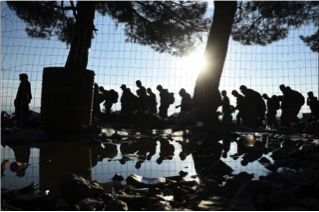The Refugee Crisis Explained

On Friday, September 11, migrants walk from northern Greece into southern Macedonia.
The European Union is facing the worst refugee crisis since World War II with an estimated 42,500 refugees arriving daily. Already, 19 million people have been forced out of their countries. Here is a rundown of the factors you should know to understand the Refugee Crisis.
What is a refugee?
According to the 1951 Refugee Convention, a refugee is someone who “owing to a well-founded fear of being persecuted for reasons of race, religion, nationality, membership of a particular social group or political opinion, is outside the country of his nationality, and is unable to, or owing to such a fear, is unwilling to avail himself of the protection of that country.” Simply stated, a refugee is someone who is forced to leave his or her country due to war, disaster, or persecution.
Where are the refugees coming from?
In general, the refugees heading to Europe are coming from Syria, Afghanistan, Iraq, Eritrea, and other Middle Eastern/African countries. The biggest producer of refugees is Syria, with 6.5 million people displaced within Syria and 4.1 million considered refugees in other nations.
Where are the refugees going?
Initially, the majority of people escaping conflict were going to Lebanon, Turkey, Jordan, and Egypt. These countries, with little aid from the international community, have been strained of all their resources and ability to host any more migrants. During the summer of 2015, refugees began a mass migration to Europe in hopes to receive asylum, particularly to Germany, Greece, Italy, France, the United Kingdom, and Sweden.
Why are they leaving their homes?
There are a variety reasons that people are fleeing the Middle East. When the Arab Spring began in 2011 and many governments were overthrown, such as Tunisia, Egypt, and Libya, Syria did not have quite the same situation. Bashar Al-Assad, President of Syria, refused to step down and is considered a quasi-dictator. As a result, a civil war has been raging on for years between the government, rebel forces, and more recently the Islamic State (ISIS/ISIL). As things only worsen and the Islamic State experiences territorial gains in Iraq and Syria, many have decided there is no hope in waiting for already desperate conditions to improve.
How is the world responding?
Neither the United Nations, the European Union, nor the international community were prepared for such an extreme influx of migrants at one time. Extreme stress has been put on European countries and the European Union to host such a large amount of people all at once. Some nations have simply refused to take in any refugees, while countries such as Germany have said they will accept any Syrian refugees within their borders; in fact, Germany has taken in more refugees in 2015 than the entire European Union in 2014. As the governments of Europe struggle to come to a consensus on how to respond, volunteers and charity organizations have been trying to fill the void with humanitarian assistance.
Much criticism has been projected towards nations such as the United Kingdom, who have said they will only accept 20,000 refugees despite having an incredibly wealthier status than countries like Jordan, which has taken in 600,000 refugees. The United States initially offered to take in 10,000 refugees; after sparking international criticism, it then raised the number to 100,000 by 2017. The majority of criticism, though, is directed at the nations of the Persian Gulf, such as Saudi Arabia, who have not taken a single refugee since the beginning of the Syrian civil war. In the face of government inaction, many citizens have taken it upon themselves to do whatever they can to help. It is important to remember that in the end, we are all humans.











































